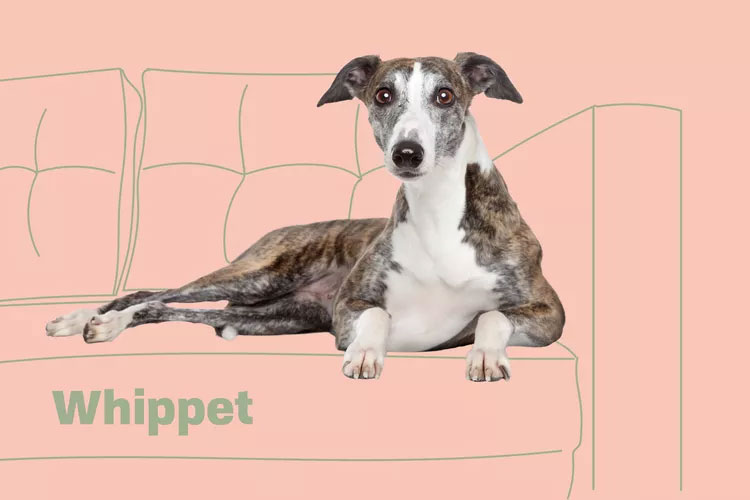
Whippet Overview
| OFFICIAL NAME | Whippet |
| COMMON NAME | Whippet |
| PET HEIGHT | 18 to 22 inches |
| PET WEIGHT | 25 to 40 pounds |
| LIFESPAN | 12 to 15 years |
| GOOD WITH | children, dogs, families, seniors |
| TEMPERAMENT | friendly, gentle, playful |
| INTELLIGENCE | medium |
| SHEDDING AMOUNT | infrequent |
| EXERCISE NEEDS | medium |
| ENERGY LEVEL | active |
| VOCAL LEVEL | quiet |
| DROOL AMOUNT | low |
| BREED GROUP | hound |
| BREED SIZE | medium (26-60 lbs.) |
| COAT LENGTH | short |
| COLORS | black, brown / chocolate / liver, cream, fawn, gray, red, white |
| PATTERNS | bicolor, brindle, flecked / ticked / speckled, liver and tan, sable, saddle / blanket, tuxedo |
| OTHER TRAITS | apartment-friendly, easy to groom, high prey drive, hot weather tolerant, strong loyalty tendencies |
While whippets are related to the greyhound and Italian greyhound from cross-breeding hundreds of years ago (and are often mistaken for these similarly shaped dogs), this sleek and friendly breed is in a class of its own. Often called the "Goldilocks" of dog breeds, they're a mid-sized dog with few grooming requirements, average exercise needs, and an easygoing temperament.
Appearance
Whippets are tall but slim dogs: Males are 19–22 inches tall, while females measure in at 18–21 inches, according to the breed standard. They weigh 25–40 pounds, so don't be alarmed if you see a skinny-looking whippet; adult whippets at a healthy weight should actually have two to four visible vertebrae.According to the whippet breed standard, their color is "immaterial." In other words, you'll find whippets in all kinds of color combinations and marking patterns, from fawn to cream, black to blue. However, the American Whippet Club notes you will not find a merle, tricolor, or harlequin whippet—if you do, this coloring indicates you're looking at a mixed breed.
Eye color can also vary, but large, dark eyes are abundant in pure-breed whippets. The whippet's large ears are rose-shaped, with a fold even when alert. This—combined with their large, dark eyes—gives them an irresistible, elfin charm.
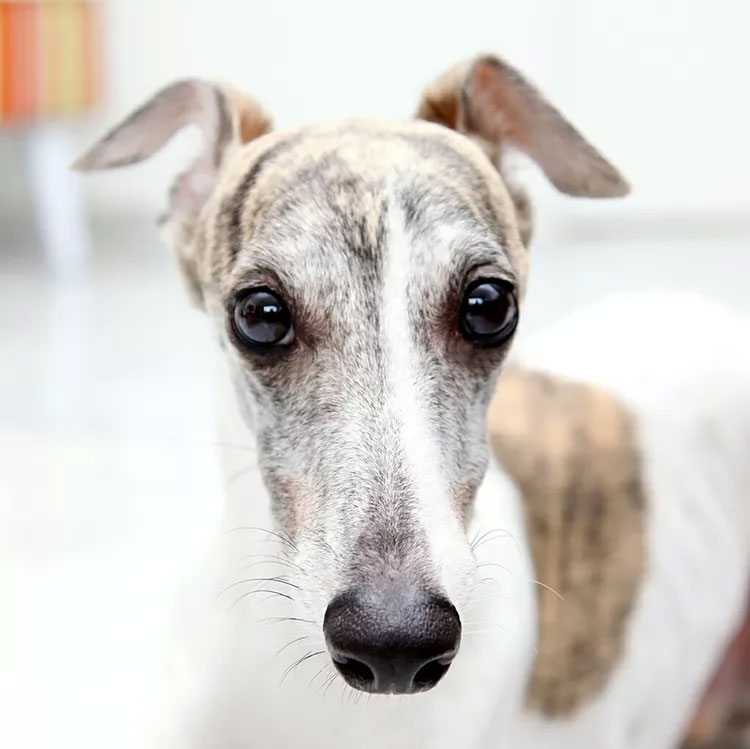
One thing to note: "The whippet breed standards are supposed to have low tail carriage," says Karen Lee, the public education chairperson and AKC delegate at the American Whippet Club. They don't have their tails tucked because they're scared or nervous, she says, so don't worry when you see a whippet with its tail between his legs.
Temperament
Whippets need a moderate amount of exercise. "They're burst exercisers, which means they can get all the exercise they need in a short amount of time with a sprint," Lee explains. As sighthounds, whippets were bred to chase down rabbits and other small game in open fields. But once they've had their exercise, they're content to lounge around the house for the rest of the day."You do need to offer them outlets for speedy bursts of galloping, that would be after a ball or a Frisbee, five to 10 minutes a day. And, you know, a nice little walk in between," Lee says.
Compared to other sighthounds (such as greyhounds), whippets are much less high-strung, says Bradley Phifer, CBCC-KA, CPDT-KSA, executive director of the Certification Council for Professional Dog Trainers.
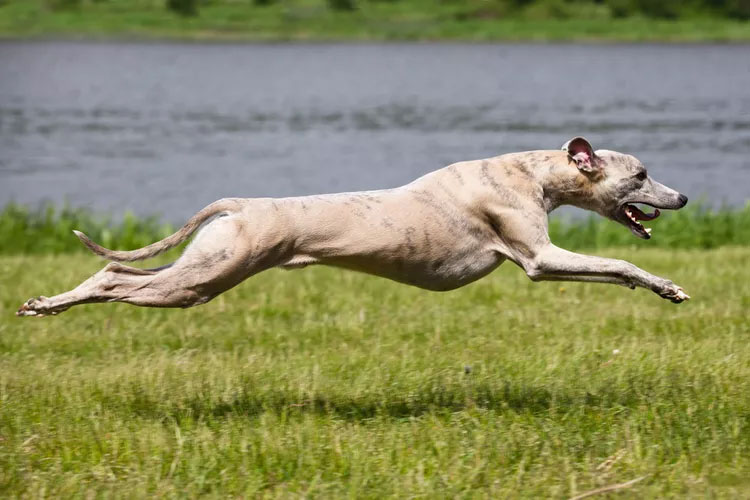
"They're a little bit more resilient," he says. "They can bounce back from stress." That being said, a whippet left alone for long stretches or without exercise can develop undesirable behaviors to keep himself busy, like eating through the curtains and couch.
Living Needs
The ideal living situation for a whippet includes a securely fenced yard—for whippets, this means a fence that is at least 6 feet high because these dogs are extremely agile. However, whippets can live in apartments as long as their owners are dedicated to getting them outside for daily walks and exercise. Once they've worked out their long legs, whippets love to lounge on couches and snuggle on laps. If you're unable to provide an exercise outlet, Lee suggests looking into adopting a senior whippet.Whippets are wonderfully gentle with children and seniors. They get along with other dogs in general, but small animals might excite their prey drive. He might not be able to resist chasing a cat running through the yard, for example, or a pet rabbit hopping across the living room floor.
Because the whippet has such low body fat, they're more tolerant of warm weather than cold weather. "Whippets are great in the summer," Phifer says. "But you're going to have to make accommodations for them in the cold weather months if you live in a cold climate."
Lee agrees. "They appreciate having a coat or a sweater … maybe even some jammies if [your] house gets cold at night," she says.

Care
While whippets do shed some, their coat is very short and easy to care for. "The advantage to the whippet is minimal grooming. They're kind of wash-and-wear with that short coat," Phifer says.Lee also notes whippets have a very low "doggy odor," so they won't need regular baths, and their ears don't retain moisture like some other breeds do. She advises keeping their nails short and wiping them down after a romp outdoors. "They're incredibly low-maintenance," she says. On top of being easy to groom, their coats are also soft and satiny to the touch.
Whippets do not bark very much and tend to be better companion dogs than sentry dogs, and they can be trained for agility competitions. Because of the intense prey drive they were bred for, it's extremely important to keep your whippet on a leash in any outdoor, unfenced situation—if he takes after a squirrel, he'll be very difficult to catch.
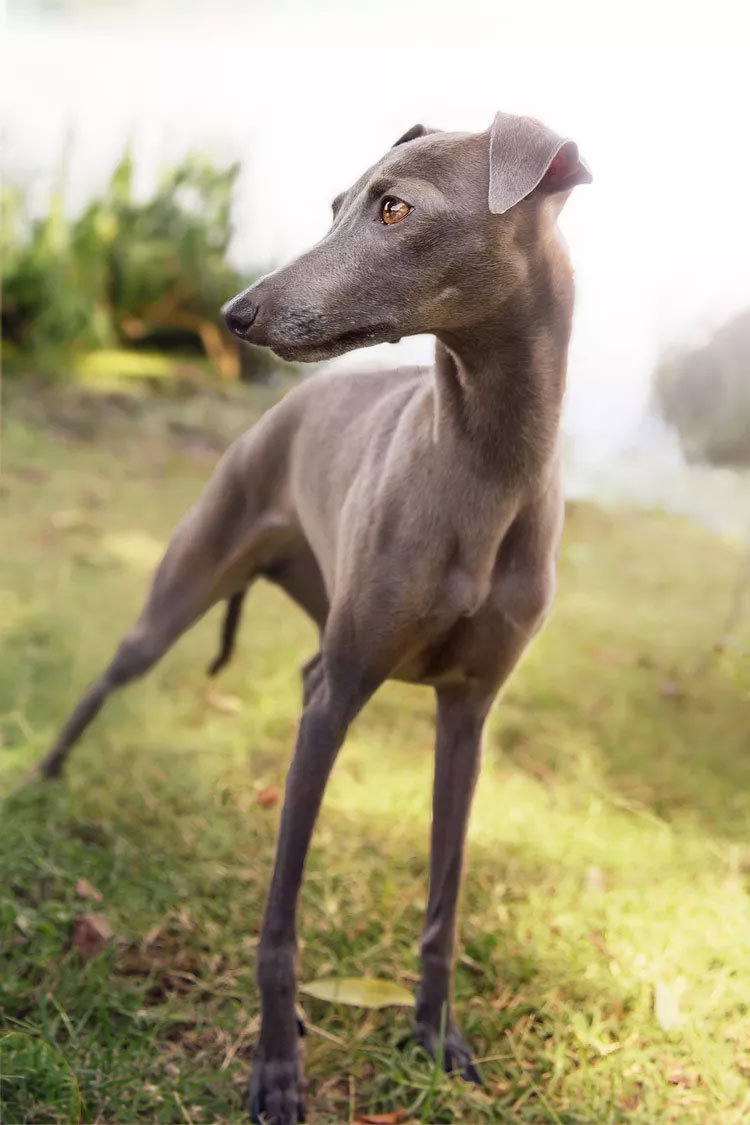
Lee offers another word of caution: "Whippets do not do well as only dogs left alone for long stretches of the day," she says. They're very social and need human and/or canine companions, which means it's best to reconsider adopting a whippet if you plan to leave the dog alone for the day.
"That is proven to create a dog with severe, severe separation anxiety," Lee cautions. She suggests doggy daycare or hiring a walker for your dog if you must be gone for long hours.
Health
According to the American Whippet Club, this is one of the healthier purebred dogs out there. That being said, it's important to help your whippet maintain a healthy weight—after all, his slender frame was not built for excess pounds.One extremely rare genetic condition that only affects whippets is called Bully Whippet Syndrome, a gene mutation affecting muscle growth. When one mutated myostatin gene is present, it can increase muscle mass and make for a stronger, faster racing dog. But when two recessive myostatin genes combine, the resulting dog is abnormally muscular—think Arnold Schwarzenegger in dog form. And bully whippets' normal-sized hearts must support these extra-large bodies, leading to heart issues.
Genetic testing can detect Bully Whippet Syndrome and other conditions that can affect your pup. The Canine Health Information Center recommends screening your whippet for hip dysplasia, deafness, and hypothyroidism, as well as conducting cardiac and eye exams.

History
The whippet originates in Northern England, and their likeness has been seen in artwork throughout antiquity, the Middle Ages, and the Renaissance, according to the American Whippet Club."Back in the mid-Victorian era, working-class people weren't allowed to really have greyhounds if you weren't landed gentry or aristocracy," Lee says.
So the miners and other working-class folks of the region cross-bred more rugged and amiable terriers with the fleet-footed greyhound, resulting in a smaller, hardier, and still-speedy dog.
"They could put a rabbit in the pot to feed the family. They made an excellent family pet," Lee says. "They also provided gambling sport on the weekends." One of the most popular whippet sports was "rag-racing," in which whippets would race each other toward fluttering rabbit skins (and later, rags) at the end of the course.
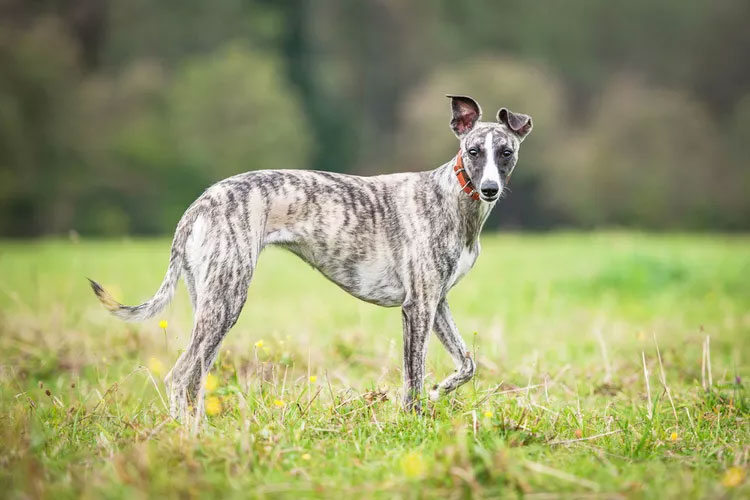
As time went on, the breed caught the attention of wealthier dog fanciers, who crossed in a little more Italian greyhound to create a slightly more elegant form. The whippet crossed over into America with English immigrants, and The American Kennel Club recognized the breed in 1888.
Whippets became especially popular in the early days of California, where they were raised as racing dogs. Douglas Fairbanks, the silent film star, even had a racing whippet.
Fun Facts
One of the newest dog sports to emerge in the last 20 years is dock diving, in which a dog vaults off of a dock into a pool of water-the dog that leaps the farthest wins. As it turns out, whippets are quite adept at dock diving. So good, in fact, the three dogs who've held the Guinness World Record for the farthest dock-diving jump are all whippets: Sounders (2019), Slingshot (2018), and Cochiti (2012).Other famous whippets include British comedian Jennifer Saunder's dog Olive, and celebrated painter Lucien Freud's dog Pluto, a frequent subject in his art. Freud once said, "I like people to look as natural and as physically at ease as animals, as Pluto my whippet."
In 2018, a whippet named Whiskey won the National Dog Show.
A whippet named Bourbon took home the Best in Show title at the 2020 AKC National Championship Presented by Royal Canin.